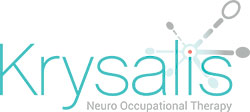Animal-assisted therapy: is there OT beauty in the beast?

Records show animals were being used in some of the earliest examples of occupational therapy by mental health reformers in 18th Century England.
Poultry, rabbits, hawks and sea gulls were seen to evoke ‘social and benevolent feelings’ among the patients interacting with them.
But, as we know now, they affect us in many more ways than that.
The real elephant in the room!
By the early 1960s, the physical, social, emotional and cognitive benefits brought by animals were being explored in healthcare and community settings across the world.
Among the inquisitors was American Dr Boris Levinson who had been noting the positive effect his own dog, Jingles had on his child patients.
His ensuing studies established him as the founder of what came to be known as animal assisted therapy (AAT).
But it would be another 20 years before AATattracted serious scientific study.
 A pet is an island of sanity in what appears to be an insane world.
A pet is an island of sanity in what appears to be an insane world. 
US Child Psychologist, Dr Boris Levinson.
Since the 1980s, a deluge of discoveries has sparked a surge in animal-assisted practices involving a wide range of domestic and wild species.
Dogs, horses, guinea pigs, fish, dolphins and, yes, even elephants have been cited as providing significant improvements in occupational therapy and mental health outcomes.
Today, the AAT industry has grown to such an extent, the UK’s Society for Companion Animal Studies is now drawing up plans to standardize and regulate it.
Leading animal study centre, Hartpury University has launched an AAT Bachelor of Science programme to meet the rising demand for scientifically led expertise, and a Cochrane review is underway to assess the effects of AAT specifically on stroke survivors, and its related feasibility and cost issues.
The results could influence the provision of AAT nationally in future.
 Skillful use of the animal by the Occupational Therapist requires a client-centered approach so that the therapist chooses an appropriate animal for each client and maximises the use of the animal in the therapeutic encounter.
Skillful use of the animal by the Occupational Therapist requires a client-centered approach so that the therapist chooses an appropriate animal for each client and maximises the use of the animal in the therapeutic encounter.
There are several theories as to how interacting with animals brings health benefits to humans, but perhaps undisputed is the attachment, bonding and social support they offer us.
Research shows the presence of a dog alone has been shown to reduce loneliness,stress and anxiety and increase motivation to participate and perform; a key occupational therapy outcome.
Horses (hippotherapy) can be incorporated into an occupational therapy plan to help achieve functional outcomes and reduce social isolation.
A study last year showed significant improvements in social behavior, verbal communication, gaze, body movement and physical contact among brain injury survivors engaging in animal therapy sessions.
And animal intervention among elderly people has been found to aid sensory modulation, range of motion, pain tolerance, alertness, attention, reminiscence and a feeling of being needed.
AAT works within the framework of occupational therapy by complementing and enhancing our profession’s clinically led practices.
Krysalis Clinical Director, Jo Throp states that ‘for many of us the connection to our pets and the care they require defines many of our daily habits and routines. They can for some people be a source of motivation, giving a reason for, and providing the opportunities to, engage with daily life and forge new social interactions following disability. Animals and in particular the pets we share our homes with, offer that valuable ‘silent unspoken support’ that can bolster our emotional wellbeing. Without us often recognising it, they provide us comfort or a confidence boost when needed. For many they bring a richness to our daily routine that is beyond value, a value that is often more keenly felt following illness or disability.’
Further reading
Rebecca and her pet therapy dog Teddy
Carrie and Turkey the rescue pooch turned therapy hero
